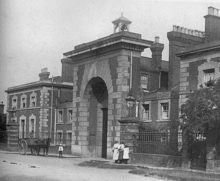HM Prison Lewes
|
Lewes Prison seen from the castle | |
| Location | Lewes, East Sussex |
|---|---|
| Security class | Adult Male/Local |
| Population | 723 (as of August 2008) |
| Opened | 1853 |
| Managed by | HM Prison Services |
| Governor | Jim Bourke |
| Website | Lewes at justice.gov.uk |
HM Prison Lewes is a local men's prison, located in Lewes in East Sussex, England. The term 'local' means that the prison holds people on remand to the local courts, as well as sentenced prisoners. The prison is operated by Her Majesty's Prison Service.
History
Lewes is a Victorian prison, built in 1853. One of its first uses was to hold three hundred Finnish grenadiers as part of the Crimean War. The guards had been captured defending Bomarsund Fortress on the Åland Islands in the Baltic Sea. The grenadiers were later released and repatriated to Finland.
Another early prisoner at Lewes was George Witton, a Lieutenant in the Bushveldt Carbineers in the Boer War in South Africa. He was imprisoned after being implicated in the shooting murder of Boer prisoners. While imprisoned in the UK from 1902, George Ramsdale Witton wrote the book "Scapegoats of the Empire". After some time Winston Churchill, himself a former prisoner of the Boers during the war, put a number of parliamentary questions to the Colonial Secretary about Witton’s ongoing incarceration. The campaign for Witton's release was successful and Witton was pardoned by King Edward VII and was freed on 10 August 1904. Witton then return to Australia where he was welcomed as a hero by the then Prime Minister of Australia, Alfred Deakin. The 1980 film "Breaker Morant" depicts the story of the court martial and conviction of Morant, Hancock and Witton.
During the 1916 Easter Rising in Ireland, several prominent figures involved in it were held at Lewes Prison, including Éamon de Valera (1882–1975); Thomas Ashe (1885–1917); Frank Lawless (1871–1922); and Harry Boland (1887–1922).
A £1 million healthcare suite opened in the prison in June 2004, with facilities to treat physically ill prisoners and a 19-bed unit for assessing mental health.[1]
In February 2008, an inspection report from Her Majesty's Chief Inspector of Prisons stated that one wing in Lewes Prison needed to be refurbished urgently after inspectors found that inmates had to eat their meals on toilets. The report also stated that anti-bullying and suicide prevention procedures at the prison were weak. However, inspectors found that vulnerable prisoners felt safe, and that the prison was decent overall.[2] Two months later a new accommodation block for 174 inmates was opened at the prison, with a commitment from prison management to refurbish older wings at Lewes within the following 12 months.[3]
On 10 April 1852, Sarah Ann French was the last female to be hung at the prison for her crime of murdering her husband William French, the murder known in East Sussex as the Onion Pie Murder. [4]
Riots
In October 2003, after 25 to 30 prisoners were involved in a riot just before nightly lock-up that led to property damage and the injury of an officer, officials launched an inquiry.[5]
In 2016 there was a riot lasting 6 hours when cells and offices were damaged, prison officers forced to retreat to safety. Mike Rolfe of the Prison Officers Association blamed severe staff shortage and bad management. Rolfee said, “There were only four staff on that wing and all four retreated to safety after threats of violence and the prisoners went on the rampage.” Two years previously a serving officer said Lewes Prison, “resembled a warzone” due to severe staff shortage and drug smuggling.[6][7]
This is one of four serious incident within under two months, Riots also happened at Birmingham Prison, Bedford Prison.[8] and Swaleside Prison.
The prison today
Lewes is a local prison, holding convicted and remand adult males mainly from East Sussex and West Sussex courts. Accommodation at the prison consists mainly of shared cells, with some single accommodation. A new house block was opened at the prison in April 2008.
The prison also has a First Night Centre for newly imprisoned / transferred inmates, and a Listener Scheme for those at risk of suicide and self-harm. The prison offers a range of full and part-time education including information technology, literacy, numeracy and life/social skills. Additional employment is offered in the prison workshops.
The most recent inspection of Lewes Prison in 2016 found it held 640 prisoners and was overcrowded. HM Chief Inspector of Prisons reported over a quarter of prisoners at Lewes said they feelt depressed or suicidal. Not all staff had anti-ligature knives and some, “could not assure us that they would act appropriately in the event of a serious self-harm incident."[9]
Notable inmates
References
- ↑ "UK | England | Southern Counties | New £1m health suite for prison". BBC News. 2004-06-10. Retrieved 2012-08-07.
- ↑ "UK | England | Sussex | Jail 'needs urgent refurbishment'". BBC News. 2008-02-05. Retrieved 2012-08-07.
- ↑ "UK | England | Sussex | Jail gets more space in new block". BBC News. 2008-04-12. Retrieved 2012-08-07.
- ↑ https://www.eastbourneherald.co.uk/lifestyle/nostalgia-where-many-infamous-criminals-met-their-end-1-7709350
- ↑ "UK | Inquiry after prison riot". BBC News. 2003-10-08. Retrieved 2012-08-07.
- ↑ Specialist officers called to Lewes prison to control six-hour riot at notorious jail once described as ‘worse than Syria’ The Independent
- ↑ Lewes Prison 'rampage' forces staff 'retreat' BBC
- ↑ HMP Birmingham prison rioters will face 'full force of law', says Truss The Guardian
- ↑ Investigation launched after two prisoners die within 48 hours at HMP Lewes The Independent
- ↑ Hardy, Jack (24 March 2017). "All the aliases used by the Westminster attacker". The Independent. Retrieved 24 March 2017.
